How to eliminate CastleLoader malware from the operating system
TrojanAlso Known As: CastleLoader virus
Get free scan and check if your device is infected.
Remove it nowTo use full-featured product, you have to purchase a license for Combo Cleaner. Seven days free trial available. Combo Cleaner is owned and operated by RCS LT, the parent company of PCRisk.com.
What kind of malware is CastleLoader?
CastleLoader is a piece of malicious software categorized as a loader. This program is designed to download/install additional malware (i.e., cause chain infections). CastleLoader has been around since at least early 2025. It has been observed being used to target governmental entities in the United States.
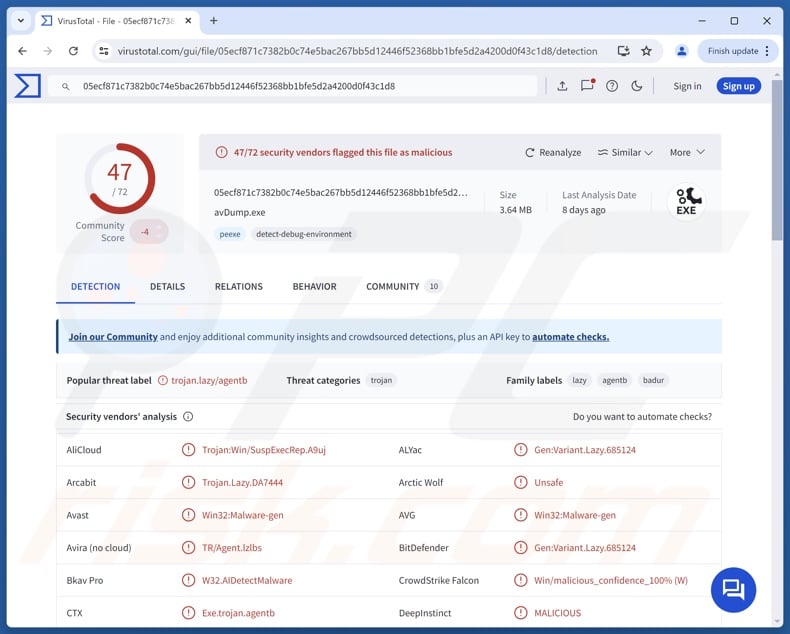
CastleLoader malware overview
As mentioned above, CastleLoader can cause chain infections by introducing malicious payloads into compromised machines. It is a sophisticated loader-type malware that uses anti-analysis mechanisms (such as detecting when launched on a virtual machine) and can escalate to run with admin privileges. This program is also capable of displaying decoy messages like fake system warnings/errors.
CastleLoader has been noted infiltrating loaders, RATs (Remote Access Trojans), and information stealers into systems. CastleLoader has used another loader – GHOSTPULSE (HIJACKLOADER) – to expand its versatility. Known remote access trojan payloads include NetSupport Manager RAT and Sectop. RATs function by enabling remote access and control over infected devices. These programs tend to have an incredibly broad application and a multitude of capabilities.
Observed stealer payloads are DeerStealer, RedLine, and Stealc. Malware within this classification steals sensitive data, such as browsing histories, Internet cookies, private files, keystrokes (keylogging), log-in credentials (usernames, passwords, passphrases, etc.), personally identifiable details, and finance-related data (e.g., banking account details, credit/debit card numbers, etc.).
Stealers can exfiltrate information from browsers, FTP (File Transfer Protocol) clients, VPNs (Virtual Private Networks), email clients, gaming-related software, cryptocurrency wallets, and so on.
It must be stressed that CastleLoader could be used to infiltrate other malicious programs into systems. To summarize, the presence of malicious software like CastleLoader on devices can lead to multiple system infections, severe privacy issues, financial losses, and identity theft.
| Name | CastleLoader virus |
| Threat Type | Trojan, loader. |
| Detection Names | Avast (Win32:Malware-gen), Combo Cleaner (Gen:Variant.Lazy.685124), ESET-NOD32 (A Variant Of Generik.HGZEIIE), Kaspersky (Trojan.Win32.Agentb.tklt), Microsoft (Trojan:Win32/Malgent!MSR), Full List Of Detections (VirusTotal) |
| Payload | GHOSTPULSE (HIJACKLOADER), NetSupport Manager RAT, Sectop, DeerStealer, RedLine, Stealc. |
| Symptoms | Trojans are designed to stealthily infiltrate the victim's computer and remain silent, and thus no particular symptoms are clearly visible on an infected machine. |
| Distribution methods | Infected email attachments, malicious online advertisements, social engineering, software 'cracks'. |
| Damage | Stolen passwords and banking information, identity theft, the victim's computer added to a botnet. |
| Malware Removal (Windows) |
To eliminate possible malware infections, scan your computer with legitimate antivirus software. Our security researchers recommend using Combo Cleaner. Download Combo CleanerTo use full-featured product, you have to purchase a license for Combo Cleaner. 7 days free trial available. Combo Cleaner is owned and operated by RCS LT, the parent company of PCRisk.com. |
Loader-type malware examples
We have written about numerous malicious programs; Olymp, BaoLoader, SoupDealer, and QuirkyLoader are merely a few of our newest articles on loaders. Software within this category downloads/installs additional malware or malicious components onto compromised machines.
Theoretically, loaders can cause just about any type of malware infections (e.g., trojans, ransomware, cryptocurrency miners, etc.). However, in practice, these programs usually operate within certain specifications or limitations.
Remember that regardless of how malware functions – its presence on a system threatens device and user safety. Hence, all threats must be eliminated immediately upon detection.
How did CastleLoader infiltrate my computer?
CastleLoader has been spread using a few different techniques. This malware was distributed via Cloudflare-themed Clickfix scams, deceptive GitHub repositories (disguised as Microsoft SQL Server Management Studio), and scam webpages distributing fake programs popular in enterprise environments (e.g., Zabbix, RVTools, etc.).
Other distribution methods are not unlikely. Generally, phishing and social engineering tactics are used to proliferate malware. Typically, malicious software is disguised as or bundled with ordinary content.
Virulent files can be archives (ZIP, RAR, etc.), executables (EXE, RUN, etc.), documents (PDF, Microsoft Office, Microsoft OneNote, etc.), JavaScript, and so forth. The infection chain may be triggered by merely opening a malicious file.
Widespread malware proliferation techniques include: drive-by (stealthy/deceptive) downloads, malvertising, malicious attachments/links in spam mail (e.g., emails, PMs/DMs, etc.), online scams, suspicious download sources (e.g., freeware and third-party sites, Peer-to-Peer sharing networks, etc.), illegal activation ("cracking") tools, and fake updates.
Furthermore, some malicious programs can self-spread through local networks and removable storage devices (e.g., external hard drives, USB flash drives, etc.).
How to avoid installation of malware?
We highly recommend downloading only from official and verified channels. All programs must be activated and updated using legitimate functions/tools, as illegal activation tools ("cracks") and third-party updates can contain malware.
Another recommendation is to be cautious when browsing since the Internet is rife with deceptive and dangerous content. Incoming emails and other messages must be approached with care. Attachments or links present in suspicious mail must not be opened, as they can be virulent.
We must emphasize the importance of having a reputable antivirus installed and kept updated. Security software must be used to perform regular system scans and to remove detected threats. If you believe that your computer is already infected, we recommend running a scan with Combo Cleaner Antivirus for Windows to automatically eliminate infiltrated malware.
Instant automatic malware removal:
Manual threat removal might be a lengthy and complicated process that requires advanced IT skills. Combo Cleaner is a professional automatic malware removal tool that is recommended to get rid of malware. Download it by clicking the button below:
DOWNLOAD Combo CleanerBy downloading any software listed on this website you agree to our Privacy Policy and Terms of Use. To use full-featured product, you have to purchase a license for Combo Cleaner. 7 days free trial available. Combo Cleaner is owned and operated by RCS LT, the parent company of PCRisk.com.
Quick menu:
- What is CastleLoader?
- STEP 1. Manual removal of CastleLoader malware.
- STEP 2. Check if your computer is clean.
How to remove malware manually?
Manual malware removal is a complicated task - usually it is best to allow antivirus or anti-malware programs to do this automatically. To remove this malware we recommend using Combo Cleaner Antivirus for Windows.
If you wish to remove malware manually, the first step is to identify the name of the malware that you are trying to remove. Here is an example of a suspicious program running on a user's computer:
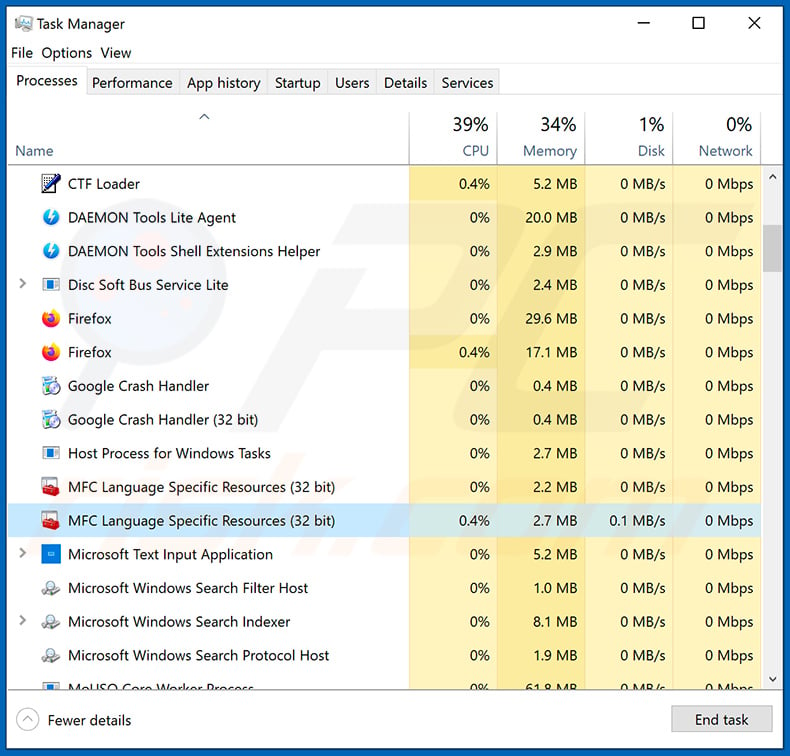
If you checked the list of programs running on your computer, for example, using task manager, and identified a program that looks suspicious, you should continue with these steps:
 Download a program called Autoruns. This program shows auto-start applications, Registry, and file system locations:
Download a program called Autoruns. This program shows auto-start applications, Registry, and file system locations:
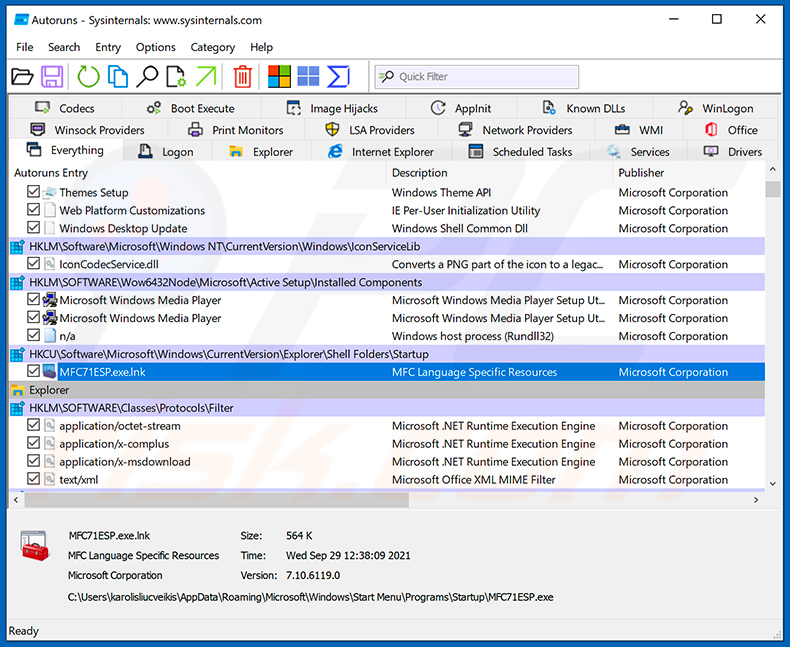
 Restart your computer into Safe Mode:
Restart your computer into Safe Mode:
Windows XP and Windows 7 users: Start your computer in Safe Mode. Click Start, click Shut Down, click Restart, click OK. During your computer start process, press the F8 key on your keyboard multiple times until you see the Windows Advanced Option menu, and then select Safe Mode with Networking from the list.
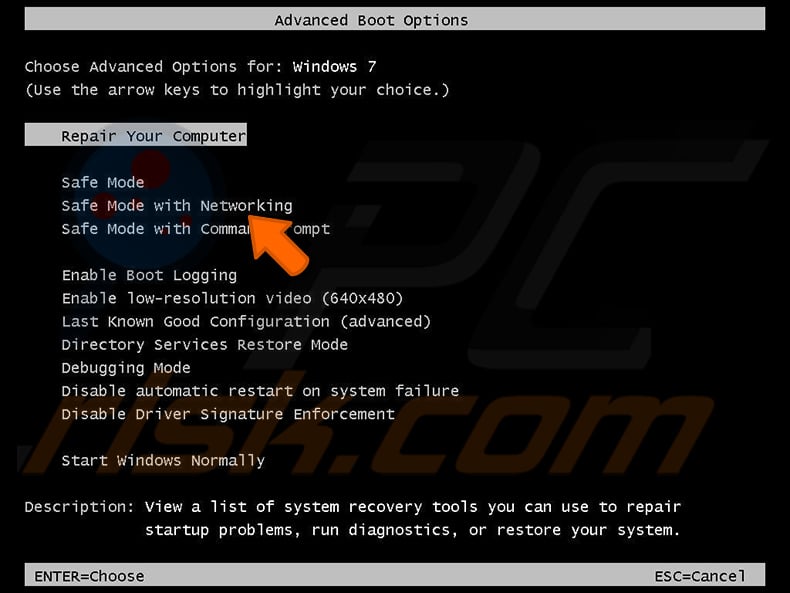
Video showing how to start Windows 7 in "Safe Mode with Networking":
Windows 8 users: Start Windows 8 is Safe Mode with Networking - Go to Windows 8 Start Screen, type Advanced, in the search results select Settings. Click Advanced startup options, in the opened "General PC Settings" window, select Advanced startup.
Click the "Restart now" button. Your computer will now restart into the "Advanced Startup options menu". Click the "Troubleshoot" button, and then click the "Advanced options" button. In the advanced option screen, click "Startup settings".
Click the "Restart" button. Your PC will restart into the Startup Settings screen. Press F5 to boot in Safe Mode with Networking.
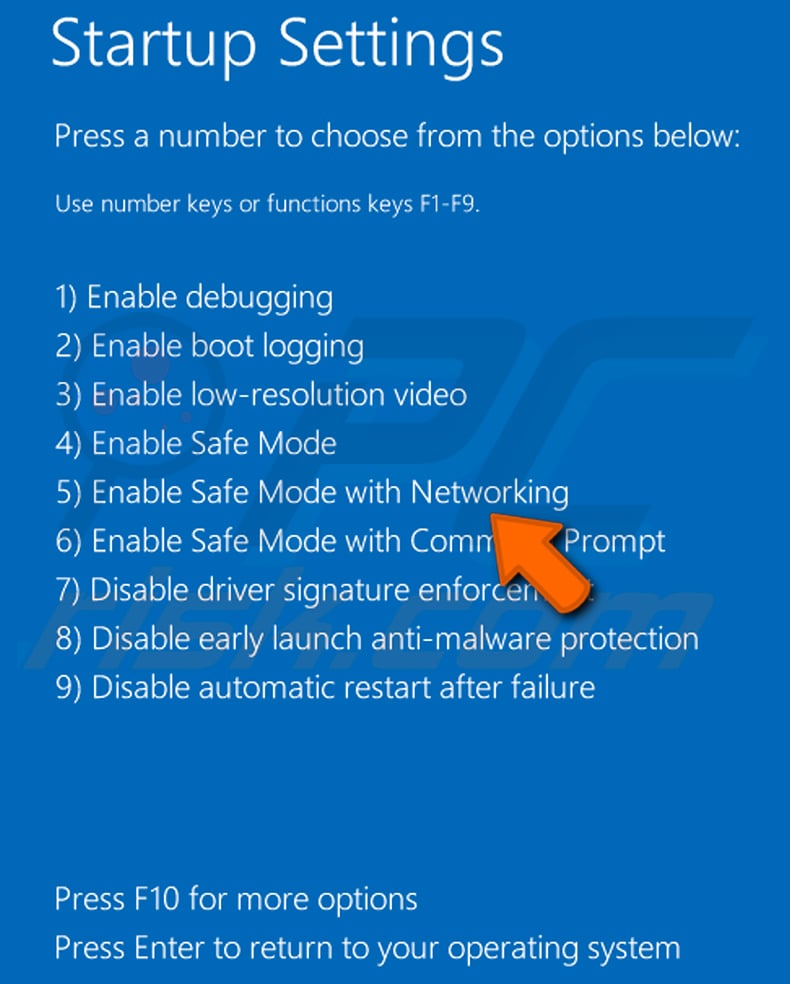
Video showing how to start Windows 8 in "Safe Mode with Networking":
Windows 10 users: Click the Windows logo and select the Power icon. In the opened menu click "Restart" while holding "Shift" button on your keyboard. In the "choose an option" window click on the "Troubleshoot", next select "Advanced options".
In the advanced options menu select "Startup Settings" and click on the "Restart" button. In the following window you should click the "F5" button on your keyboard. This will restart your operating system in safe mode with networking.
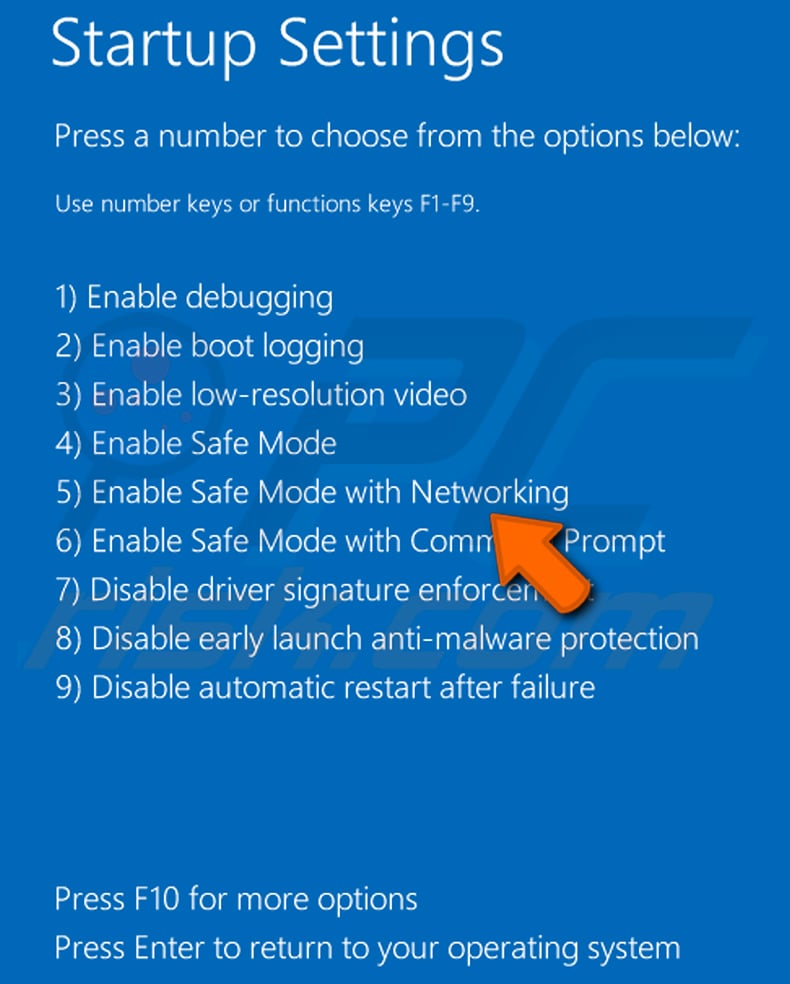
Video showing how to start Windows 10 in "Safe Mode with Networking":
 Extract the downloaded archive and run the Autoruns.exe file.
Extract the downloaded archive and run the Autoruns.exe file.
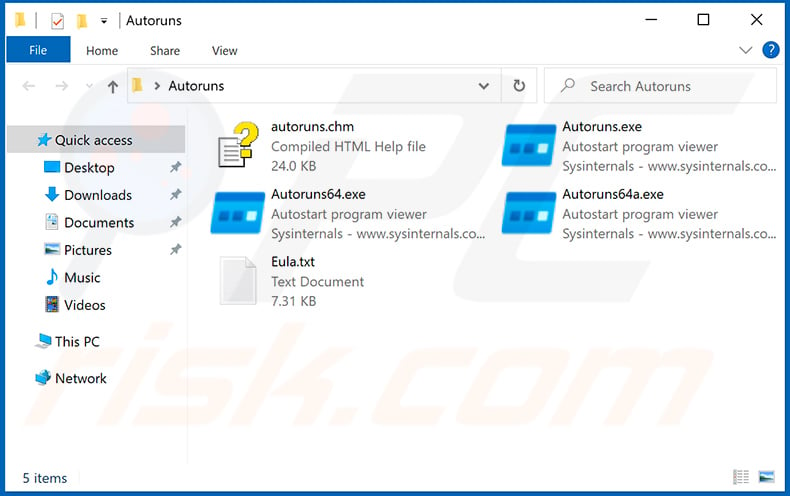
 In the Autoruns application, click "Options" at the top and uncheck "Hide Empty Locations" and "Hide Windows Entries" options. After this procedure, click the "Refresh" icon.
In the Autoruns application, click "Options" at the top and uncheck "Hide Empty Locations" and "Hide Windows Entries" options. After this procedure, click the "Refresh" icon.
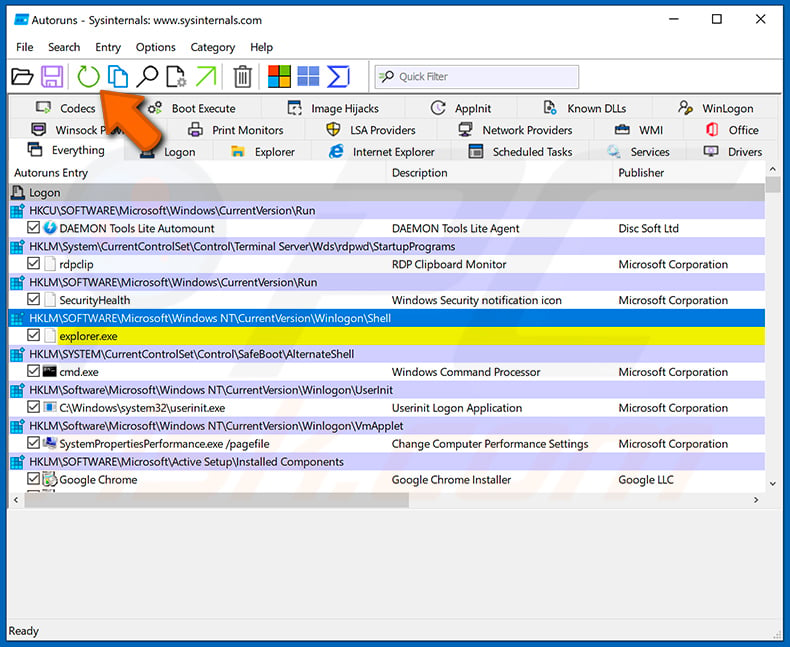
 Check the list provided by the Autoruns application and locate the malware file that you want to eliminate.
Check the list provided by the Autoruns application and locate the malware file that you want to eliminate.
You should write down its full path and name. Note that some malware hides process names under legitimate Windows process names. At this stage, it is very important to avoid removing system files. After you locate the suspicious program you wish to remove, right click your mouse over its name and choose "Delete".
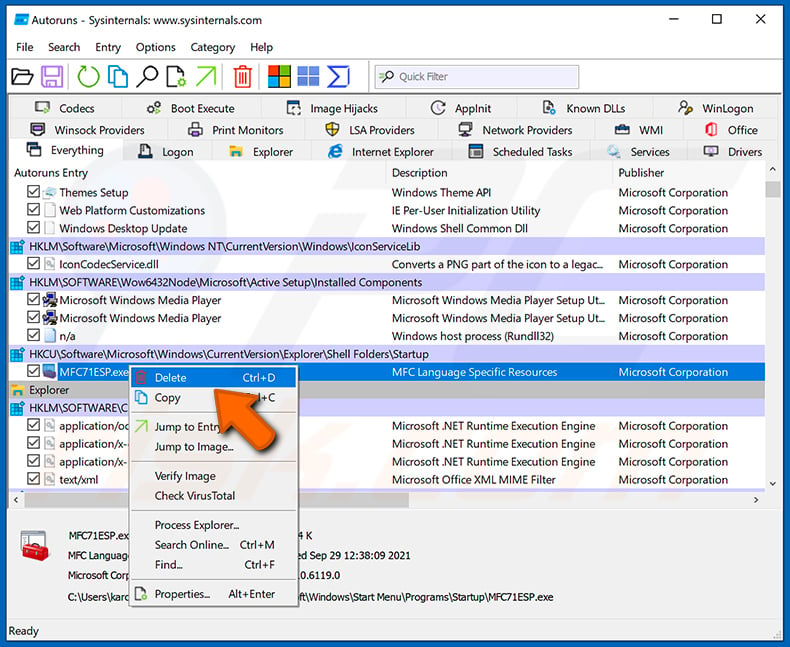
After removing the malware through the Autoruns application (this ensures that the malware will not run automatically on the next system startup), you should search for the malware name on your computer. Be sure to enable hidden files and folders before proceeding. If you find the filename of the malware, be sure to remove it.
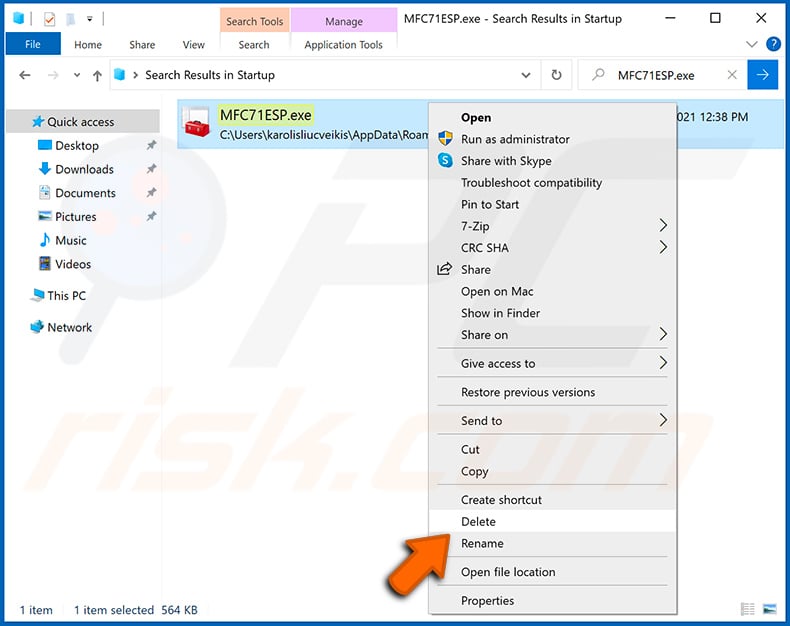
Reboot your computer in normal mode. Following these steps should remove any malware from your computer. Note that manual threat removal requires advanced computer skills. If you do not have these skills, leave malware removal to antivirus and anti-malware programs.
These steps might not work with advanced malware infections. As always it is best to prevent infection than try to remove malware later. To keep your computer safe, install the latest operating system updates and use antivirus software. To be sure your computer is free of malware infections, we recommend scanning it with Combo Cleaner Antivirus for Windows.
Frequently Asked Questions (FAQ)
My computer is infected with CastleLoader malware, should I format my storage device to get rid of it?
Most likely, no. Malware removal seldom necessitates formatting.
What are the biggest issues that CastleLoader malware can cause?
The dangers associated with an infection depend on the malware's functionalities and the attackers' goals. CastleLoader is designed to cause chain infections, and it has been used to load RATs and stealers. Generally, malware of this kind can cause multiple system infections, severe privacy issues, financial losses, and identity theft.
What is the purpose of CastleLoader malware?
Malware is primarily used to generate revenue. Other potential motivations include: attackers seeking amusement or personal grudge realization, process disruption (e.g., websites, services, companies, organizations, etc.), hacktivism, and political/geopolitical reasons.
How did CastleLoader malware infiltrate my computer?
CastleLoader has been proliferated through Clickfix scams, fake enterprise software download sites, and deceptive GitHub repositories.
Different distribution techniques are possible. Prevalent ones include: drive-by downloads, spam emails/messages, malvertising, online scams, dubious download channels (e.g., freeware and third-party websites, P2P sharing networks, etc.), illegal activation tools ("cracks"), and fake updates. Some malicious programs can self-spread via local networks and removable storage devices.
Will Combo Cleaner protect me from malware?
Yes, Combo Cleaner can detect and remove practically all known malware infections. Keep in mind that performing a complete system scan is paramount since high-end malicious software usually hides deep within systems.
Share:

Tomas Meskauskas
Expert security researcher, professional malware analyst
I am passionate about computer security and technology. I have an experience of over 10 years working in various companies related to computer technical issue solving and Internet security. I have been working as an author and editor for pcrisk.com since 2010. Follow me on Twitter and LinkedIn to stay informed about the latest online security threats.
PCrisk security portal is brought by a company RCS LT.
Joined forces of security researchers help educate computer users about the latest online security threats. More information about the company RCS LT.
Our malware removal guides are free. However, if you want to support us you can send us a donation.
DonatePCrisk security portal is brought by a company RCS LT.
Joined forces of security researchers help educate computer users about the latest online security threats. More information about the company RCS LT.
Our malware removal guides are free. However, if you want to support us you can send us a donation.
Donate
▼ Show Discussion